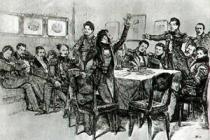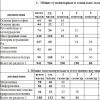Publisher Marketing
Moscow State University of Printing Arts
Zharkov V. M., Kuznetsov B. A., Chistova I. M.
1. Marketing activities of the publishing house
1. 1. Goals of marketing activities of the publishing house
First of all, it should be noted that there is no single understanding of what marketing is. And yet, as a starting point, we will define marketing activities in the field of book publishing as a set of activities to identify the needs of potential readers and satisfy them in literature.
released products.
We can say that marketing is a set of activities to study all issues related to the products of a publishing house, such as:
consumer research;
research into the motives of his behavior in the market;
analysis of forms and channels of product sales;
analysis of trade volume;
studying the competitor, determining the forms and level of competition;
determining the most effective ways to promote books on the market;
studying its “niche” market, where the publishing house has the best opportunities compared to its competitors to sell its products.
The difference between publishing marketing and marketing in a bookselling enterprise lies, in particular, in the fact that in the latter case there is a ready-made product - a book, with which the book trade works, while the publisher deals with the marketing of a product that does not exist in any material form - book ideas. Therefore, the goal of the publishing house’s marketing activities can be called ensuring economic efficiency from the implementation of the book program.
1. 2. Editor and marketing
The work of a modern editor includes a whole range of areas related to the development and implementation of ideas not only for a specific publication or book, but also for larger publishing projects. One of these areas is marketing. An editor should not begin to think about the market for a book when the finished manuscript or fragment of it lands on his desk. When this happens, it is often difficult to change anything, in any case, this may be associated with financial losses or additional costs.
Whether this book is needed and whether it can be sold at a price acceptable to the publishing house must be decided before the author receives an order for it, and the publishing house begins to create a favorable environment for its existence in the future.
When making a decision, the editor uses not only personal experience and intuition. If necessary, he consults with specialists in a particular field of knowledge, studies the market, analyzes literature related to the topic, consults with colleagues, that is, forms and studies the maximum possible database on the subject of the book or area with which he is currently working.
3. Marketing planning
3. 1. Development of a marketing plan
A marketing plan is usually developed for each book. It includes all the elements necessary to prepare the book for sale and position it in the market. The work of preparing a marketing plan begins the moment the editor begins working on the manuscript. Sometimes at an earlier stage, when there is no manuscript yet, but the idea of the book has already acquired real features.
The most effective is the view of planning set forth in Philip Kotler’s now classic book “Fundamentals of Marketing,” which we will take as a basis.
Summary of Benchmarks. This initial part of the plan sets out its main goals and objectives, forms the main focus of the plan and its structure.
Current marketing situation. An important part of the plan that characterizes the starting situation for a new publishing product. This includes a description of the market.
Dangers and opportunities. The problems that may arise when promoting a product to the market and its sale are outlined.
Tasks and problems. This section of the plan is a logical continuation of the previous one, since the tasks and problems identified in it arise from the analysis of dangers and opportunities.
Marketing strategy. It is a logical structure outlining ways to solve marketing problems in the medium and long term.
Budgets. The previous sections of the plan allow you to build the financial side of the plan and predict possible profits and losses. Once approved, the budget portion of the plan serves as the basis for the implementation of the entire marketing plan.
Thus, the marketing plan allows you to present in a concentrated form the situation with the creation, promotion to the market and sale of a specific publishing product, starting from the earliest stage of working with it.
3. 2. Marketing budget
A marketing budget is an action plan for its implementation in monetary terms. Its successful implementation means ensuring acceptable costs for the implementation of all marketing plan activities.
The marketing budget is usually planned on the basis of the publisher's planned annual turnover, that is, it depends on the annual income.
4. 1. Market segmentation
One of the main concepts in marketing is “need” - discomfort in a person’s behavior, activity, feelings, or more simply - a need for something that requires satisfaction.
To satisfy a consumer's need for a book, the publisher must research the market. But this study is also necessary in order to reduce costs and increase publishing revenues. One of the most important marketing tools is market segmentation.
A market segment is a specially selected part of the market, a group of consumers, products or enterprises that have certain common characteristics.
The most common criteria for market segmentation include (given from the book: Modern Marketing / Edited by V. E. Khrutsky. - M.: Finance and Statistics, 1991. - P. 62-63.):
the significance of the segment (its stability, growth opportunities);
A real assessment of the potential of a publishing house using these criteria allows us to evaluate not only the possibilities of entering new markets, but also the stability of the position in the segment in which the publishing house traditionally operates.
4. 2. Selection of target market segments
When looking for a solution, you can use three strategies to reach the market: undifferentiated, differentiated and concentrated marketing.
Undifferentiated marketing. Its essence lies in the production of goods aimed at the mass consumer, the mass reader. This approach is very economical, since the costs of production and sales, as well as advertising and marketing, are low.
Differentiated Marketing. In this case, the publishing house acts simultaneously in several segments and creates an independent publishing program for each.
Concentrated marketing. This option is chosen, as a rule, by medium and small publishing houses when they concentrate their efforts on a relatively narrow type, target or thematic market of technical or medical, educational or computer literature.
4. 3. Positioning the book on the market
When we talk about positioning, we mean providing a book with a place in the market that is different from other books and unique to this particular book. In fact, we are talking about creating a separate niche for a specific publication in the minds of the buyer. Hence the importance of positioning in the marketing activities of a publishing house.
Positioning of a book uses, first of all, its attributes such as title, format, binding, artistic design of the book itself or the dust jacket, text on its flaps, and price. Taken together, they should attract the buyer’s attention, provide a recognition effect, make the book stand out from the crowd, and encourage a potential consumer to buy the book. And if all this is built correctly and works, then those characteristics of the book that distinguish it from other books are perceived by buyers as its unique advantages.
Every publisher dreams that his book not only finds its reader and is needed and useful, but also has commercial success
For a long time, a powerful book publishing industry was created in Russia. It is not for nothing that at the turn of the 70s and 80s our country was called the most read country in the world. This was achieved by taking full advantage of the planning and distribution system and the development of the printing industry. It was during this period that the network of state publishing houses, which specialized in branches of knowledge, was strengthened, and powerful printing plants were built. In Fig. Figure 14.1 schematically shows the system of book publishing and distribution of book products that was formed during that period.
Despite the widespread use of economic management methods in the industry (book publishing was one of the leading industries that took into account the opinions and desires of consumers), the dominant management paradigm at that time, focused on the efficient use of the capacities of printing plants, could not limit the possibilities.
Publishin g
Manufacturing
printed
products
industry in terms of the range of books published and their circulation. Monopolized book trade was also a limitation. All this together created, through the state plan, a strict mechanism for regulating publishing activities, pricing policy and book distribution.
The beginning of the 90s was marked by a change in the general situation in the economy and social life of the state; at this time, the state plan was abandoned, commodity-money relations received priority, non-state publishing houses appeared, printing enterprises were partially privatized, and non-state trade developed. All this together changed the external environment of publishing houses, primarily state-owned ones, and predetermined the need for a radical restructuring of all their work and their orientation towards the interests of consumers. First of all, this meant that in making decisions on publishing policy it was necessary to proceed from the wishes of the consumers themselves and, moreover, it turned out to be important to anticipate changes in their desires.
In Fig. 14.2 schematically presents the new structure of the publishing house’s activities, when its starting points are the needs (desires) of a person.
The range of activities of a publishing house to identify the needs of potential readers and satisfy them in the literature is designated as marketing activities, or marketing. The figure shows (sht-
edited fragments) that marketing activities influence the activities of the publishing house at the beginning of the production cycle (thematic planning) and at its completion (sales of the published book).
A schematic representation of the marketing activities of a publishing house in market conditions shows that the range of problems that a publishing house is traditionally forced to deal with, and its activities in connection with meeting specific market needs and the emergence of

Satisfying needs
Selling books
new ones become cyclical. Satisfaction of one problem usually entails the birth of a new one at a higher level.
The study of identified patterns in this activity, what is usually called the scientific approach, appeared only after the Second World War. This process is most often identified today with the concept of “marketing”. The very concept of “marketing” has not yet been established; it is constantly expanding and covers more and more new areas of activity. As an example, here are two definitions of marketing.
One of the recognized classics of marketing, F. Kotler, defines it as follows: “Marketing is the work with the market of radio exchanges, the purpose of which is to satisfy needs and requirements... Marketing is a type of human activity aimed at satisfying needs and requirements through exchange” [Kotler F. Fundamentals of Marketing / Translated . from English M.: Progress, 1990. P. 78].
The concept of marketing changed constantly as the system of exchange in social production developed. Our compatriot V. Khrutskoy in the 90s defines marketing in the following way: “Marketing is a complex of activities to study all issues related to the process of selling an enterprise’s products. This includes:
consumer research; research into the motives of his behavior in the market;
analysis of the enterprise’s own market; research of a product (product or type of service); analysis of forms and channels of sales (sales) of products; analysis of trade volume;
studying competitors, determining the forms and level of competition;
Evolution of the concept and goals of marketing activities
the study of a market “niche” - an area of production or commercial activity in which an enterprise has the best opportunities (in comparison with potential competitors) to realize its advantages to increase turnover” [Modern Marketing / Ed. V.E. Khrutsky. M.: Finance and Statistics, 1991- P. 28].
Thus, as knowledge about marketing activities deepens, it comes to the understanding that marketing not only affects commercial activities, but also invades new areas of human activity. In order for marketing to become not only a theoretical model, but also an effective publishing policy, it is necessary to consider its main key concepts and the logical connections between them.
In Fig. Figure 14.3 shows the structural model of marketing, which we will use to uncover marketing opportunities in a publishing house. The concept of “marketing” is inextricably linked with other keywords: “demand”, “profit”, “marketing tools”, “marketing concept”, as well as with the implementation of the functions of this activity. The first attempt to build a structural model of this concept using the Hypertext method was made in the work Novitskaya E.V., Evseeva O.B. Economic Dictionary: Hypertext for Young Businessmen [M.: Finance and Statistics, 1994], when through key concepts and their logical connections marketing is presented as a multifaceted and complex activity. A visual representation of marketing allows you to better imagine marketing activities and determine its place in the market.
The marketing model presented generally follows the structure of the material covered in the book, with each major element framed and related concepts discussed sequentially in their respective chapters.
Marketing as a science arose immediately after the Second World War, when it was necessary to create a system of pro-
sales of American goods taking into account the demand and interests of buyers. It was then that a fundamental separation of the functions of selling goods from the personality of the seller occurred. The emergence of a unique division of labor in trade gave a significant impetus to the organization of this activity. In order to illustrate how the content of the concept of “marketing” has changed over time, the basic principles and keywords characterizing it at different stages of development are presented in Table. 14.1. The table shows that at each stage of the development of marketing activities, the same concept of “marketing” practically denoted the activities of the company, which were different in content and objects of influence.

defines strategy |
|||||||||||||||||
competition |
Marketing |
||||||||||||||||
firms in conditions |
|||||||||||||||||
being built in |
|||||||||||||||||
According to |
|||||||||||||||||
marketing concept |
|||||||||||||||||
grocery; 2) technological; |
|||||||||||||||||
sales; 4) market; |
|||||||||||||||||
social and ethical |
performs |
||||||||||||||||
provides
includes
marketing mix
product, price, |
||||||
this is specific |
||||||
place, condition |
||||||
combination |
||||||
tools |
stimulation |
|||||
included in |
||||||
planning |
planning |
planning |
pricing |
control |
|||||||||||
marketing |
consumers |
goods (services) |
commodity circulation |
promotion |
in marketing |
marketing, |
|||||||||
environment and market |
development |
||||||||||||||
marketing |
|||||||||||||||
according |
|||||||||||||||
through |
|||||||||||||||
with theory |
|||||||||||||||
vital |
demand generation |
||||||||||||||
segmentation |
|||||||||||||||
and stimulation |
|||||||||||||||
sales (FOSSTIS) |
|||||||||||||||
Marketing doesn't exist. And yet, as the initial one we define marketing activities in the field of book publishing a set of activities to identify the needs of potential readers and satisfy them in literature.
Marketing activities have the most active influence on the activities of a publishing house at the beginning of the production cycle, at the stage of thematic planning, and at its completion, at the stage of sales of released products.
We can say that marketing is a set of activities to study all issues related to the products of a publishing house, such as:
consumer research;
research into the motives of his behavior in the market;
analysis of the publishing house’s own market;
analysis of forms and channels of product sales;
analysis of trade volume;
studying the competitor, determining the forms and level of competition;
determining the most effective ways to promote books on the market;
studying its “niche” market, where the publishing house has the best opportunities compared to its competitors to sell its products.
The difference between publishing marketing and marketing in a bookselling enterprise lies, in particular, in the fact that in the latter case there is a ready-made product - a book, with which the book trade works, while the publisher deals with the marketing of a product that does not exist in any material form - book ideas. Therefore, the goal of the publishing house’s marketing activities can be called ensuring economic efficiency from the implementation of the book program.
8.1.2. Editor and Marketing
The work of a modern editor includes a whole range of areas related to the development and implementation of ideas not only for a specific publication or book, but also for larger publishing projects. One of these areas is marketing. An editor should not begin to think about the market for a book when the finished manuscript or fragment of it lands on his desk. When this happens, it is often difficult to change anything, in any case, this may be associated with financial losses or additional costs.
Whether this book is needed and whether it can be sold at a price acceptable to the publishing house must be decided before the author receives an order for it, and the publishing house begins to create a favorable environment for its existence in the future.
When making a decision, the editor uses not only personal experience and intuition. If necessary, he consults with specialists in a particular field of knowledge, studies the market, analyzes literature related to the topic, consults with colleagues, that is, forms and studies the maximum possible database on the subject of the book or area with which he is currently working.
8.3. Marketing planning
8.3.1. Development of a marketing plan
A marketing plan is usually developed for each book. It includes all the elements necessary to prepare the book for sale and position it in the market. The work of preparing a marketing plan begins the moment the editor begins working on the manuscript. Sometimes at an earlier stage, when there is no manuscript yet, but the idea of the book has already acquired real features.
The most effective is the view of planning set forth in Philip Kotler’s now classic book “Fundamentals of Marketing,” which we will take as a basis.
Benchmark Summary. This initial part of the plan sets out its main goals and objectives, forms the main focus of the plan and its structure.
Current Marketing Situation. An important part of the plan that characterizes the starting situation for a new publishing product. This includes a description of the market.
Dangers and Opportunities. The problems that may arise when promoting a product to the market and its sale are outlined.
Tasks and problems. This section of the plan is a logical continuation of the previous one, since the tasks and problems identified in it arise from the analysis of dangers and opportunities.
Marketing strategy. It is a logical structure outlining ways to solve marketing problems in the medium and long term.
Action program. Here, specific activities and actions are formulated to achieve the intended goals and implement the chosen strategies.
Budgets. The previous sections of the plan allow you to build the financial side of the plan and predict possible profits and losses. Once approved, the budget portion of the plan serves as the basis for the implementation of the entire marketing plan.
Control procedure. Includes the procedure for monitoring the implementation of the marketing plan.
Thus, the marketing plan allows you to present in a concentrated form the situation with the creation, promotion to the market and sale of a specific publishing product, starting from the earliest stage of working with it.
8.3.2. Marketing budget
This is an action plan for its implementation in monetary terms. Its successful implementation means ensuring acceptable costs for the implementation of all marketing plan activities.
The marketing budget is usually planned on the basis of the publisher's planned annual turnover, that is, it depends on the annual income.
8.4. Studying market demand
8.4.1. Market segmentation
One of the main concepts in marketing is “need” - discomfort in a person’s behavior, activity, feelings, or more simply - a need for something that requires satisfaction.
To satisfy a consumer's need for a book, the publisher must research the market. But this study is also necessary in order to reduce costs and increase publishing revenues. One of the most important marketing tools is market segmentation.
A specially selected part of the market, a group of consumers, products or enterprises that have certain common characteristics.
The most common criteria for market segmentation include (given from the book: Modern Marketing / Edited by V.E. Khrutsky. - M.: Finance and Statistics, 1991. - P. 62-63.):
quantitative parameters of the segment (number of potential consumers, segment capacity in terms of sales and cost, geography of consumers);
accessibility of the segment for the publishing house (possibility of using sales channels, conditions of transportation and storage, adequacy of the capacity of sales channels);
the significance of the segment (its stability, growth opportunities);
profitability of the segment (how profitable the publishing house’s work in this segment will be);
compatibility of the segment with the market of its main competitors (to what extent competitors will oppose the approval of the publisher’s products in this segment);
efficiency of work on the selected segment (the publishing house has the capabilities to work on the selected segment: experience, personnel, readiness to compete);
protection of the selected segment from competition (assessment of possible competitors and the publishing house’s own strengths to withstand competition).
A real assessment of the potential of a publishing house using these criteria allows us to evaluate not only the possibilities of entering new markets, but also the stability of the position in the segment in which the publishing house traditionally operates.
The emergence and development of the publishing business is associated with the beginning of the “Gutenberg era” (15th century), when movable type was invented. The improvement of printing technology led to the rapid growth of not only book printing, but also the production of newspapers and magazines. The rise in the cultural level of society, especially in the 20th century, contributed to the emergence of not just a literate reader, but also entire audiences of consumers of printed information.
The formation of the market for publishing products began even earlier than the emergence of book printing. At all times and eras, the merchant class needed economic information. Information was needed about the situations in the first international markets, exchanges, about the ratio of the values of different currencies (parity), about the conditions of the markets for various goods - food, textiles, furs, wax, etc. Producers of goods - factory owners, manufacturers, manufacturers - needed to know where and at what price they could profitably sell their products. Information was required in the form of newspaper and magazine reviews, special market magazines, and books on the economic development of society.
With the development of market relations, the demand for printed publications - books, newspapers, magazines - has constantly increased. The book in this area became a commodity that generated significant income. The book production process is becoming highly productive, which creates a need for large working capital. Banking structures willingly supply publishers with the financial resources necessary for typesetting, layout and printing of books, newspapers and magazines. Finding these funds through a loan turned out to be difficult, so the process of concentrating capital directly in the hands of the publisher began.
The process of concentration of capital is closely related to such factors as the speed of book printing, which, in turn, required the introduction of the latest achievements of science and technology: cheap paper, high-quality dyes, high-speed printing equipment.
At different stages of the economic development of book printing, its importance and impact on society either intensified or weakened. Nevertheless, the formation of its most important characteristics under the influence of the economy is undeniable.
Publishing is a type of productive activity characterized by:
targeted nature;
the presence of means of production with which the object of production – a book – is processed;
interaction between the manufacturer and the buyer of a product within the framework of the “book publisher – reader” model.
At the same time, book publishing differs in many ways from the usual production of goods; it has its own specifics: the producers are, first of all, the author of the book or a journalist who, using specific means of labor, use special methods, methods, and techniques inherent only in this field of activity. Book, newspaper and magazine information is information processed in a special way, which makes it easier to perceive and influence the consumer.
Publishing products can be considered as a product with a dual nature. Firstly, it is a product of spiritual creativity, created for the purpose of human intellectual development. Influencing the spiritual sphere of a person, encouraging him to improve in the direction of changing reality (government, culture, economy), the book remains the main ideological weapon in the hands of a person. Secondly, a book can be considered as a product that creates its own market - the market for book products. It has long been dominated by special market relations.
Coursework in the discipline
“Economics and organization of publishing activities” on the topic:
Features of the publishing house's marketing activities
Moscow
2009/2010
Table of contents
The essence and content of marketing 4
Features of Publishing Marketing 6
Marketing Concepts 8
Marketing planning 12
Marketing budget 15
The editor and his role in marketing planning for the publishing business 18
Conclusion 20
List of used literature 21
Introduction
If we are talking about production activities, then marketing is a system for organizing all the activities of a company in the development, production and marketing of goods based on a comprehensive study of the market and real customer requests in order to obtain high profits. In other words, the modern marketing system makes the production of goods dependent on consumer demands.
In each field of activity, marketing has its own specifics, associated primarily with the characteristics of a particular product and its market. In our case, it is important to consider publishing marketing; it also has its own specifics. As a specific action or sequence of specific operations, it deals with two main components: a product, which can be either a material object (in our case a book) or an ideal one (for example, the idea of publishing a new series of cookery books), and the buyer this product. It is the interaction of these two components and their impact on the activities of the publishing company that we will try to consider in this work.
The essence and content of marketing
Marketing - this is a type of human activity aimed at satisfying needs and requirements through exchange 1.
But this definition does not provide the necessary answer; it only asks new questions. In search of the best, Philip Kotler himself offers more than one formulation of the term:
Marketing is a social process aimed at satisfying the needs and desires of individuals and groups through the creation, supply and free exchange of valuable goods and services 2 .
Or even like this:
Marketing - is the art and science of choosing the right target market, attracting, retaining and increasing the number of consumers by creating confidence in the buyer that he represents the highest value to the company,” as well as “an orderly and targeted process of understanding consumer problems and regulating market activity 3.
Marketing how the economic process ensures contact between producer and consumer and contributes to the efficiency of their exchanges. As a result, it is the goal-setting beginning of production, a means of minimizing the discrepancy between supply and demand. In this capacity, marketing establishes and constantly supports not only commodity, but also information exchange between potential participants in market relations. The need for it is higher, the more producers of homogeneous products confront buyers who need them.
All this is general marketing, but most modern textbooks call marketing activities aimed at promoting a product to the market, creating demand for it and satisfying this demand.
Marketing - wide-ranging activities in the field of the market for goods, services, and securities, carried out in order to stimulate the sale of goods, develop and accelerate exchange, in the name of better satisfying needs and making a profit 4 .
Features of Publishing Marketing
Publisher Marketing - a set of activities to identify the needs of potential readers and satisfy them in literature.
Marketing activities have the most active influence on the activities of a publishing house at the beginning of the production cycle, at the stage of thematic planning and at its completion - at the stage of sales of released products. However, marketing, to one degree or another, is a component of each stage of work on a book and is a set of activities to study all issues related to the publishing house’s products:
- study of potential consumers;
analysis of the market in which the publishing house’s products are sold;
analysis of forms and channels of product sales;
analysis of the volume of trade turnover, potential sales market and the publishing house’s own products;
study of the competitive environment;
study of advertising activities;
determining the most effective ways to promote books on the market;
studying your “niche” market, where the publishing house has advantages over its competitors.
The main goal of the marketing activities of the publishing house in general can be called ensuring economic efficiency from the implementation of the book program. To the same general Marketing goals also include those that determine the policy of a publisher in a certain period of time in a certain market. These may be the goals of providing the greatest possible variety of publishing products in order to satisfy the needs of customers in the widest possible range, the goals of achieving leadership in the all-Russian or regional book markets, etc.
Along with the general goals of publishing marketing, there are also local goals. Thus, in the course of implementing the publishing house’s long-term goals, separate marketing campaigns are also carried out, aimed, for example, at promoting a specific publishing project or popularizing an author or a book series.
The need for marketing appears along with the emergence of competition. Competition- the struggle for more favorable conditions for the production and sale of goods on the market. Market- economic relations associated with the exchange of goods and services, as a result of which demand, supply and price are formed.
Historically, the marketing orientation in the Russian market has changed from production, through sales and product, to the buyer. In addition to these goals, marketing, to one degree or another, is always aimed at creating a comfortable business environment, at better investment of capital, at creating a stable prospect for the development of a specific commercial structure, which is especially important in recent times.
Marketing Concepts
There are five main marketing concepts on the basis of which enterprises conduct their activities:
- production (the concept of production improvement);
commodity (the concept of improving a product);
sales (the concept of intensifying commercial efforts);
market (the concept of “consumer” marketing);
concept of social and ethical marketing.
This concept is based on the predisposition of consumers to widespread and affordable goods, which requires constant improvement of technology and production organization, increasing volumes and reducing production costs. At the same time, all attention is focused on internal production capabilities, which makes it possible to saturate the market with any product or service. This approach is quite justified when demand significantly exceeds supply or when the cost of producing a unit of goods is quite large and needs to be reduced through mass production of products.
The production concept was used by most enterprises of the former USSR. This was due to the fact that demand for almost all goods significantly exceeded supply and enterprises were forced to constantly increase production volumes. This approach did not always ensure that the real needs of the population were taken into account, but due to mass production it made it possible to produce relatively cheap goods.
Product concept
The product concept assumes that consumers will favor products that are of the highest quality at reasonable and affordable prices. This means that the company’s efforts are primarily focused on the constant improvement of its products. In relation to the publishing business, this most often means the creation of a new publishing product that was previously absent from the book market.
The concept of product improvement was quite widely used by enterprises in the printing industry in the recent past, when the so-called “scarce market” operated and there were many unknown authors and even thematic areas.
It is also possible to improve the publication by improving the quality of printing or developing an improved design, but all this makes it not only better, but at the same time more expensive. So in both cases it is necessary to search for your reader, your buyer.
Sales concept
This concept has become a natural result of the development of production and product concepts, which, while paying maximum attention to increasing production and improving the product, practically do not engage in a thorough study and formation of the market. In such conditions, sooner or later the sales problem will worsen, when the enterprise tries to sell already produced goods by all means and methods available to it. Consequently, in practice, the implementation of the sales concept is essentially associated with the imposition of a purchase. This concept can be described as aggressive marketing. Moreover, the seller strives to conclude a deal at all costs, and satisfying the needs of buyers is a secondary point for him.
An example of the implementation of this concept in publishing is selling books over the Internet. The world's largest online bookstore is the American Amazon.
Market concept
This concept is that the condition for a successful enterprise is to identify the needs and requirements in target markets and provide the desired customer satisfaction in ways that are more efficient and more productive than those of competitors. The company coordinates its activities with the expectation of ensuring the interests of customers, making a profit precisely by creating and maintaining consumer demand.
This concept is similar to the previous one, but unlike it, it is focused on the needs of the buyer, not the seller.
At the same time, the tasks facing publishers producing different book products may differ significantly depending on the product. When implementing this concept, it is important to obtain information about consumer requests from the reader himself, for which various surveys and marketing research are conducted.
Social and ethical marketing concept
The social and ethical concept of marketing differs from the “ordinary” concept of marketing in that the goal of the first is to ensure the long-term well-being of not only an individual enterprise, but also society as a whole.
Therefore, at least four points must be taken into account when marketing management at the enterprise level:
- buyer (consumer) needs;
vital interests of the consumer;
interests of the enterprise;
interests of society.
The choice of a particular concept by an enterprise in the printing industry should be determined by the goals and objectives of its activities in the market in the coming period. It should be noted that each marketing concept has merits and can ensure success in real market conditions. Today, businesses most often choose to combine concepts.
Marketing planning
Planning- one of the components of management, which consists in the development and practical implementation of plans that determine the future state of the economic system, ways, means and means of achieving it. Marketing planning- development of plans for research, production, advertising, sales and other activities related to the production, promotion and sale of goods or services.
There is no rigid and generally accepted marketing planning scheme acceptable for any publishing house. Sometimes such planning is reduced to a description of standard sales promotion techniques, a list of operations for advertising a future book, and a study of the product itself and the market in which it is intended to be sold. It seems, however, that the more acceptable view of marketing planning is set out in F. Kotler’s classic book “Fundamentals of Marketing.”
The following sections of the marketing plan are formed based on the strategic goals of a specific publishing structure and the nature of the publishing product planned for release:
Benchmark Summary
This initial part of the plan sets out its main goals and objectives, forming the main focus and its structure.
Current Marketing Situation
An important part of the plan, which characterizes the starting situation for a new publishing product. There is also a description of the market in which the book will be sold, in terms of its size, the presence of analogues or substitutes. It also characterizes the positions of competing publishing houses and the publishing house itself that produces the new product, and examines the likely channels for supplying the book to the market and their potential in terms of sales volumes.
Dangers and Opportunities
The directions of marketing efforts that can positively influence the situation and increase the competitiveness of the publication are outlined, as well as the problems that may arise when promoting a product to the market and its sale.
Tasks and problems
The tasks and problems identified in it are a logical continuation of the previous section; they arise from an analysis of dangers and opportunities and are formulated in the form of specific targets with a specified time frame for implementation.
Marketing strategy
It is a logical structure outlining ways to solve marketing problems in the medium and long term. Specific strategies for a new product, organizing its sale, advertising, and sales promotion are described. This section should provide answers to questions posed in previous sections of the plan.
Marketing strategy- key areas of the publishing house’s activities to maintain demand for its products, depending on the current market situation. Includes specific strategies by target markets, marketing mix, and level of marketing spend. Marketing mix- a set of controllable marketing variables (product, price, methods of distribution and promotion), the totality of which is used by the publishing house to form a favorable reaction from the target market.
Action program
This section formulates specific activities and actions to achieve the intended goals and implement the selected strategies. Here the questions need to be answered: what will be done, when will it be done, who will do it and how much will it cost?
Budgets
Based on the previous sections of the plan, its financial side is built, possible profits and losses are predicted. Once approved, the budget portion of the plan serves as the basis for the implementation of the entire marketing plan.
Control procedure
Includes the procedure for monitoring the implementation of the marketing plan. This procedure is structured so that it is possible, within a certain period of time, to evaluate the results achieved and, if necessary, to determine measures to correct the situation.
Thus, the marketing plan allows you to present in a concentrated form the situation with the creation, promotion to the market and sale of a specific publishing product, starting from the earliest stage of working with it.
Marketing budget
The marketing budget is formed so that sales are ensured and funds are received from the sale of the publication, which would not only cover production and sales costs, but also generate the necessary income to replenish the publishing house’s net profit. It must be remembered that the marketing budget is formed along with budgets for other areas of the publishing house’s activities and cannot be considered in isolation from them.
The budget for marketing expenses in each specific period is a certain percentage of the sales volume of all products of the publishing house, although expenses for each specific book can vary significantly depending on a number of factors, in particular, on the circulation, quality of execution, readership of the book and others. Accordingly, the share of marketing expenses can vary over a fairly wide range: from 5% for mass publications to 20% for professional directories.
Most often, the marketing budget is usually planned based on the planned annual turnover of the publisher, that is, it depends on the annual income.
In addition to the sales percentage method, other financing methods are used:
Method of financing "from the possible"
The essence of the method is to answer the question - how much can you allocate? This method is used by enterprises focused on production rather than marketing. The latter usually accounts for only what remains after satisfying the demands of production as such (if anything remains). The only, but very dubious, advantage of the method is the absence of any serious conflicts with production departments due to unconditional priority. The imperfection of the method lies primarily in the impossibility of developing long-term marketing programs, planning the marketing mix and the entire activity of the enterprise.
Competitive parity method
The method involves taking into account the practices and level of marketing costs of competing enterprises, adjusted for the balance of power and market share. For its implementation, a number of conditions must be present. First, you should select a competitor who is close in resources, interests and market position. Secondly, it is necessary to at least approximately determine the size of its marketing budget, which is very difficult.
Method "from what has been achieved"
This method is based on the deduction of a certain percentage of the previous or expected sales volume. For example, a value of 3% of last year’s sales is assumed. This method is quite simple and is often used in practice. However, it is also the least logical, since it makes the cause (marketing) dependent on the effect (sales volume). When focusing on the results of the past period, marketing development becomes possible only if it is previously successful.
Maximum Expense Method
The method assumes that it is necessary to spend as much money as possible on marketing. Despite the apparent “progressiveness” of this approach, its weakness lies in its neglect of ways to optimize costs. Moreover, given the fairly significant time interval between the implementation of marketing expenses and the achievement of results, the use of this method can too quickly lead the enterprise to difficult financial difficulties.
Method based on goals and objectives
This method requires a coherent system of clearly formulated goals and objectives. The essence of the method comes down to calculating the costs to be incurred as part of individual marketing activities to ensure the achievement of the corresponding goals. Therefore, in such cases, a revision of the goals is often required. Only a few businesses turn to this method of financing.
Marketing program accounting method
The method involves careful consideration of the costs of achieving specific goals, but not in themselves, but in comparison with the costs of other possible combinations of marketing means, i.e., when implementing other “chains” of marketing strategy alternatives.
However, in practice, integrated approaches are used when forming a marketing budget, suggesting a certain symbiosis of the methods discussed above.
The editor and his role in marketing planning for the publishing business
It is necessary to decide whether this book is needed, whether it can be sold at a price acceptable to the publisher, and many other issues before work begins on turning the project into reality. True, this applies to a lesser extent to fiction, where it is much more difficult to “guess” or “calculate” the fate of a work. However, for scientific, educational, reference, and popular science literature, this approach is often the only correct one. In any case, the editor’s task, already at the initial stage of working with a future book, is not only to determine his attitude towards it, but also, if possible, to find a solution to those problems that may arise on the way of the book to the reader.
It is important to note that depending on the size of the publishing house, the degree of responsibility of the editor for making decisions in this part varies, since in large publishing houses such decisions are made by professional marketers, not editors. However, there are few such publishers. In medium and small publishing houses, the role of the editor as an expert in marketing matters is much more noticeable, and sometimes even decisive. Here he himself decides what to publish, and he himself is responsible for promoting the book to the reader.
When making a decision, the editor must use more than just personal experience and intuition. It is necessary to consult with specialists
in a specific field of knowledge and carefully study the market, that is, it is important to create the most complete database on the subject of the publication.
To a certain extent, the nature of the editor’s work as a marketer is determined by the marketing concept adopted by the publishing house to solve current or future problems.
Conclusion
etc.................














